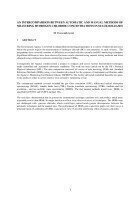Air monitoring
AN INTERCOMPARISON BETWEEN AUTOMATIC AND MANUAL METHODS OF MEASURING HYDROGEN CHLORIDE CONCENTRATIONS IN STACK RELEASES
Oct 06 2014
Author: M J Lewandowski on behalf of CEM
1 ABSTRACT
The Environment Agency is involved in independent monitoring programmes at a variety of industrial processes where the permits require the measurement of hydrogen chloride (HCl) concentrations in stack releases. The programmes have revealed a number of difficulties associated with the currently used HCl monitoring techniques. Significant differences have been observed between results obtained using manual testing methods and those obtained using continuous emission monitoring systems (CEMs).
Consequently the Agency commissioned a project to compare and assess various measurement techniques under controlled and repeatable laboratory conditions. The work has been carried out by the UK’s National Physical Laboratory (NPL). The inter-comparison consisted of a series of tests involving CEMs and Standard Reference Methods (SRMs) using a test chamber developed for the purpose of instrument certification under the Agency’s Monitoring Certification Scheme (MCERTS). The facility delivered controlled traceable test gases to the analysers either in across-stack or in an extractive monitoring set-up.
The instrumental methods covered included the gas filter correlation (GFC), differential optical absorption spectroscopy (DOAS), tunable diode laser (TDL), Fourier transform spectroscopy (FTIR)- medium and low resolution , and ion mobility mass spectrometry (IMMS). The two manual methods tested were SRMs as specified by EN1911 and US EPA method 26A.
The tests have demonstrated that in general the instrumental techniques perform well and produce much more repeatable results than SRMs. No major interferent effects were observed across all techniques. The SRMs were not challenged with gaseous chlorides which would have caused much greater discrepancies between the automatic techniques and the manual ones. The performance of SRMs puts a question mark over their use as a principal means of calibration of CEMs especially in view of possible interfering effect of gaseous chlorides.
Digital Edition
IET 35.2 March
April 2025
Air Monitoring - Probe Sampling in Hazardous Areas Under Extreme Conditions - New, Game-Changing Sensor for Methane Emissions - Blue Sky Thinking: a 50-year Retrospective on Technological Prog...
View all digital editions
Events
Apr 08 2025 Birmingham, UK
Apr 08 2025 Targi Kielce, Poland
Apr 08 2025 Baku, Azerbaijan
Apr 08 2025 Bahrain
Apr 10 2025 Beijing, China















